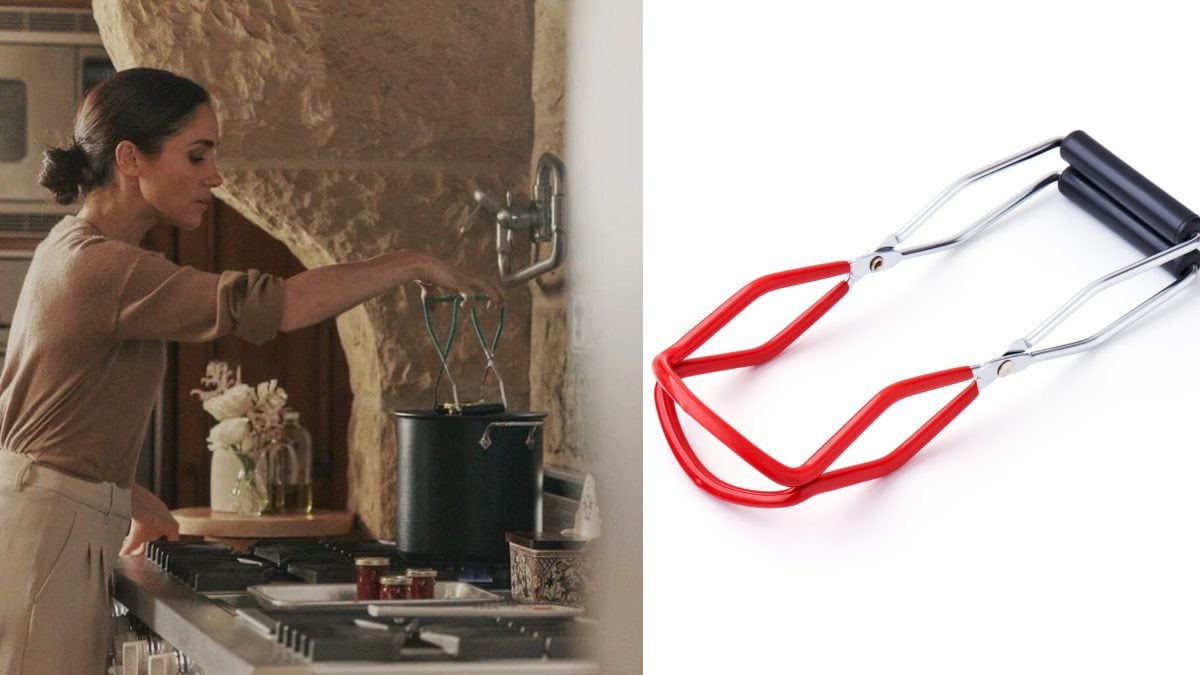
Recently, eagle-eyed viewers noticed Meghan Markle, in promotional photos for her As Ever line of preserves, holding canning jar tongs (also known as jar lifters) upside down while lifting hot jars from a pot.
The complaint? The rubber-coated side, which is meant to grip the neck or body of the hot jar securely to prevent slipping, was pointing upward instead of downward, leaving the metal side in contact with the jar.
Delish’s Senior Food Director confirmed the move was unsafe, noting that when jar lifters are misused, the jar can shift, slip, or even break — especially when hot glass meets moisture.
While some defended her (claiming the particular tongs allowed reversible grip), most canners saw this as a basic error in tool use. Let’s see why properly orienting your canning tongs matters.
The Mechanics of Jar Lifters
Canning jar lifters are simple but engineered tools. Their design generally includes:
- Rubber or silicone-coated grips that curve or clamp to the jar’s neck or body.
- A metal arm or frame that provides structure and leverage.
- Handles that open and close to engage or release the jar.
When used upside down, the rubber gripper is inverted, giving poor grip and increasing the risk of slippage. Moreover, the metal side may press against the glass without cushioning, risking cracks or breakage. Hot jars become harder to stabilize, especially when transferring from boiling water to another surface and if dropped, spills, burns, and broken glass become real safety hazards.
What Can Go Wrong
When the grip is incorrect, jars can shift or tilt mid-lift, increasing the chance of glass failure. Hot preserves or water can spill onto your hands or stovetop, causing burns or mess. Dropping a hot jar onto a cold surface (like a cold baking sheet) can lead to thermal shock, where sudden temperature change causes the glass to crack or shatter. Delish warns that Meghan’s method — if placing jars directly on cold pans — adds to this danger. Even if breakage doesn’t occur, slippage or tilting can lead to spilled or contaminated preserves, undoing hours of work.

How to Use Canning Tongs (Jar Lifters) Correctly
Here’s a step-by-step of how pros and home canners correctly use jar lifters:
- Check your tool orientation. Ensure the rubber-coated or silicone grip faces downward, to wrap around the jar’s neck or body.
- Open the lifter fully, then place it carefully around the jar you wish to lift.
- Grip firmly but gently. Squeeze handles until the rubber wraps snugly around the jar’s neck/body.
- Lift straight up. Avoid tilting or pulling sideways, especially while still in the water.
- Move steadily. Keep the jar upright as you move it to a new surface.
- Release over a towel or rack. To reduce shock, place a towel or rubber mat beneath the jar rather than a cold metal pan.
- Avoid direct cold surfaces. If you must place the jar down, use a kitchen towel or insulated surface to prevent thermal shock.
Following these practices greatly reduces the risks Meghan appeared to ignore.
Tips & Best Practices for Safe Canning
Before you begin canning, take a moment to inspect your tools carefully. Any cracks or wear in the rubber grips can compromise safety and make it harder to hold jars securely. It’s a good idea to practice with empty jars first, especially if you’re new to canning or using a new pair of tongs — this helps you get comfortable with the weight and balance before handling hot contents.
When dealing with heavier jars, use two hands for stability: one to control the lifter and the other to steady the jar as you transfer it. Always be mindful of your surface, too. Placing a hot jar directly on a cold or wet surface can cause it to crack or shatter from thermal shock. Let each jar drip for a few seconds after lifting it from the boiling water to remove excess moisture, which helps prevent slipping.
And finally, keep a towel nearby — not only to catch drips but also to soften the landing in case a jar slips from your grip. These simple habits can make your canning process safer, smoother, and far less stressful.
;Resize,width=767;)
